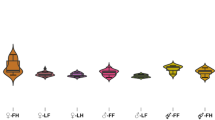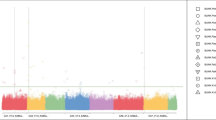Abstract
Peanut (Arachis hypogaea L.) is one of the most important oilseed and nutritional crops in the world. To efficiently utilize the germplasm collection, a peanut mini-core containing 112 accessions was established in the United States. To determine the population structure and its impact on marker–trait association, this mini-core collection was assessed by genotyping 94 accessions with 81 SSR markers and two functional SNP markers from fatty acid desaturase 2 (FAD2). Seed quality traits (including oil content, fatty acid composition, flavonoids, and resveratrol) were obtained through nuclear magnetic resonance (NMR), gas chromatography (GC), and high-performance liquid chromatography (HPLC) analysis. Genetic diversity and population structure analysis identified four major subpopulations that are related to four botanical varieties. Model comparison with different levels of population structure and kinship control was conducted for each trait and association analyses with the selected models verified that the functional SNP from the FAD2A gene is significantly associated with oleic acid (C18:1), linoleic acid (C18:2), and oleic-to-linoleic (O/L) ratio across this diverse collection. Even though the allele distribution of FAD2A was structured among the four subpopulations, the effect of FAD2A gene remained significant after controlling population structure and had a likelihood-ratio-based R 2 (R 2 LR ) value of 0.05 (oleic acid), 0.09 (linoleic acid), and 0.07 (O/L ratio) because the FAD2A alleles were not completely fixed within subpopulations. Our genetic analysis demonstrated that this peanut mini-core panel is suitable for association mapping. Phenotypic characterization for seed quality traits and association testing of the functional SNP from FAD2A gene provided information for further breeding and genetic research.


Similar content being viewed by others
References
Barkley NA, Dean R, Pittman RN, Wang ML, Holbrook CC, Pederson GA (2007) Genetic diversity of cultivated and wild-type peanuts evaluated with M13-tailed SSR markers and sequencing. Genet Res 89:93–106
Barkley NA, Chenault-Chamberlin KD, Wang ML, Pittman RN (2010) Development of a real-time PCR genotyping assay to identify high oleic acid peanuts (Arachis hypogaea L.). Mol Breed 25:541–548
Barkley NA, Wang ML, Pittman RN (2011) A real-time PCR genotyping assay to detect FAD2A SNPs in peanuts (Arachis hypogaea L.). Electron J Biotechnol. doi: 10.2225/vol14-issue1-fulltext-12
Baur JA, Sinclair DA (2006) Therapeutic potential of resveratrol: the in vivo evidence. Nat Rev Drug Discov 5:493–506
Bradbury PJ, Zhang Z, Kroon DE, Casstevens TM, Ramdoss Y, Buckler ES (2007) TASSEL: software for association mapping of complex traits in diverse samples. Bioinformatics 23:2633–2635
Bruner AC, Jung S, Abbott AG, Powell GL (2001) The naturally occurring high oleate oil character in some peanut varieties results from reduced oleoyl-PC desaturase activity from mutation of aspartate 150 to asparagines. Crop Sci 41:522–526
Cavalli-Sforza LL, Edwards AWF (1967) Phylogenetic analysis: Models and estimation procedures. Am J Hum Genet 19:233–257
Chen Z, Wang ML, Barkley NA, Pittman RN (2010) A simple allele-specific PCR assay for detecting FAD2 alleles in both A and B genomes of the cultivated peanut for high-oleate trait selection. Plant Mol Biol Rep 28:542–548
Chu Y, Ramos L, Holbrook CC, Ozias-Akins P (2007) Frequency of a loss-of-function mutation in oleoyl-PC desaturase (ahFAD2A) in the mini-core of the US peanut germplasm collection. Crop Sci 47:2372–2378
Chu Y, Holbrook CC, Ozias-Akins P (2009) Two alleles of ahFAD2B control the high oleic acid trait in cultivated peanut. Crop Sci 49:2029–2036
Dean LL, Hendrix KW, Holbrook CC, Sanders TH (2009) Content of some nutrients in the core of the core of the peanut germplasm collection. Peanut Sci 36:104–120
Evanno G, Regnaut S, Goudet J (2005) Detecting the number of clusters of individuals using the software structure: a simulation study. Mol Ecol 14:2611–2620
Excoffier L, Lischer HEL (2010) Arlequin suite ver 3.5: a new series of programs to perform population genetics analyses under Linux and Windows. Mol Ecol Res 10:564–567
Falush D, Stephens M, Pritchard JK (2003) Inference of population structure using multilocus genotype data: linked loci and correlated allele frequencies. Genetics 164:1567–1587
Ferguson ME, Burow MD, Schulze SR, Bramel PJ, Paterson AH, Kresovich S, Mitchell S (2004) Microsatellite identification and characterization in peanut (A. hypogaea L.). Theor Appl Genet 108:1064–1070
Hardy OJ, Vekemans X (2002) SPAGeDi: a versatile computer program to analyze spatial genetic structure at the individual or population levels. Mol Ecol Notes 2:618–620
He G, Ming R, Newman M, Gao G, Pittman RN, Prakash CS (2003) Microsatellites as DNA markers in cultivated peanut (Arachis hypogaea L.). BMC Plant Biol 3:3
Holbrook CC, Dong W (2005) Development and evaluation of a mini core collection for the US peanut germplasm collection. Crop Sci 45:1540–1544
Holbrook CC, Anderson WF, Pittman RN (1993) Selection of a core collection from the US germplasm collection of peanut. Crop Sci 33:859–861
Hopkins MS, Casa AM, Wang T, Mitchell SE, Dean RE, Kochert GD, Kresovich S (1999) Discovery and characterization of polymorphic simple sequence repeats (SSRs) in peanut. Crop Sci 39:1243–1247
Isleib TG, Holbrook CC, Gorbet DW (2001) Use of plant introductions in peanut cultivar development. Peanut Sci 28:96–113
Jung S, Powell G, Moore K, Abbott A (2000a) The high oleate trait in the cultivated peanut [Arachis hypogaea L.]. II. Molecular basis and genetics of the trait. Mol Gen Genet 263:806–811
Jung S, Swift D, Sengoku E, Pate M, Teule F, Powell G, Moore K, Abbott A (2000b) The high oleate trait in the cultivated peanut [Arachis hypogaea L.]. I. Isolation and characterization of two genes encoding microsomal oleoyl-PC desaturase. Mol Gen Genet 263:796–805
King RE, Bomser JA, Min DB (2006) Bioactivity of resveratrol. Compr Rev Food Sci Food Safety 5:65–70
Knauft DA, Chiyembekeza AJ, Gorbet DW (1992) Possible reproductive factors contributing to outcrossing in peanut (Arachis hypogaea L.). Peanut Sci 19:29–31
Kottapalli KR, Burow MD, Burow G, Burke J, Puppala N (2007) Molecular characterization of the US peanut mini core collection using microsatellite markers. Crop Sci 47:1718–1727
Krapovickas A, Gregory WC (1994) Taxonomia del énero Arachis (Leguminosae). Bonplandia 8:1–186
Kwak M, Gepts P (2009) Structure of genetic diversity in the two major gene pools of common bean (Phaseolus vulgaris L., Fabaceae). Theor Appl Genet 118:979–992
Li Y, Chen CY, Knapp SJ, Culbreath AK, Holbrook CC, Guo BZ (2011) Characterization of simple sequence repeat (SSR) markers and genetic relationships within cultivated peanut (Arachis hypogaea L.). Peanut Sci (in press)
Liang X, Chen X, Hong Y, Liu H, Zhou G, Li S, Guo B (2009) Utility of EST-derived SSR in cultivated peanut (Arachis hypogaea L.) and Arachis wild species. BMC Plant Biol 9:35
Liu K, Muse SV (2005) PowerMarker: integrate analysis environment for genetic marker data. Bioinformatics 21:2128–2129
Loiselle BA, Sork VL, Nason J, Graham C (1995) Spatial genetic structure of a tropical understory shrub, Psychotria officinalis (Rubiaceae). Am J Bot 82:1420–1425
López Y, Nadaf HL, Smith OD, Connell JP, Reddy AS, Fritz AK (2000) Isolation and characterization of the Delta (12)-fatty acid desaturase in peanut (Arachis hypogaea L.) and search for polymorphisms for the high oleate trait in Spanish market-type lines. Theor Appl Gent 101:1131–1138
Moretzsohn MC, Hopkins M, Mitchell SE, Kresovich S, Valls JFM, Ferreira ME (2004) Genetic diversity of peanut (Arachis hypogaea L.) and its wild relatives based on the analysis of hypervariable regions of the genome. BMC Plant Biol 4:11
Moretzsohn MC, Leoi L, Proite K, Guimarães PM, Leal-Bertioli SCM, Gimenes MA, Martins WS, Valls JFM, Grattapaglia D, Bertioli DJ (2005) A microsatellite-based, gene-rich linkage map for the AA genome of Arachis (Fabaceae). Theor Appl Genet 111:1060–1071
Myles S, Peiffer J, Brown PJ, Ersoz ES, Zhang Z, Costich DE, Buckler ES (2009) Association mapping: critical considerations shift from genotyping to experimental design. Plant Cell 21:2194–2202
Norden AJ, Lipscomb RW, Carver WA (1969) Registration of Florunner peanuts. Crop Sci 9:850
Norden AJ, Gorbet DW, Knauft DA, Young CT (1987) Variability in oil quality among peanut genotypes in the Florida breeding program. Peanut Sci 14:7–11
O’Byrne DJ, Knauft DA, Shireman RN (1997) Low fat-monounsaturated rich diets containing high-oleic peanuts improves serum lipoprotein profile. Lipids 32:687–695
Pancholy SK, Despande AS, Krall S (1978) Amino acids, oil and protein content of some selected peanut cultivars. Proc Am Peanut Res Edu Assoc 10:30–37
Patterson N, Price AL, Reich D (2006) Population structure and eigenanalysis. PloS Genet 2:e190
Price AL, Patterson NJ, Plenge RM, Weiblatt ME, Shadick NA, Reich D (2007) Principal components analysis corrects for stratification in genome-wide association studies. Nat Genet 38:904–909
Pritchard J, Stephens M, Donnelly P (2000) Inference of population structure using multilocus genotype data. Genetics 155:945–959
Qin H, Chen C, Feng S, Guo Y, Knapp S, Culbreath A, He G, Wang ML, Zhang X, Holbrook CC, Ozias-Akins P, Liang X, Guo B (2011) An integrated genetic linkage map of cultivated peanut (Arachis hypogaea L.) constructed from two RIL populations. Theor Appl Genet (submitted)
Sanders TH, McMichael RW, Hendrix KW (2000) Occurrence of resveratrol in edible peanuts. J Agric Food Chem 48:1243–1246
SAS Institute (1999) SAS/STAT user’s guide version 8. Cary
Sobolev VS, Cole RJ (1999) Trans-resveratrol content in commercial peanuts and peanut products. J Agric Food Chem 47:1435–1439
Sun G, Zhu C, Kramer MH, Yang SS, Song W, Piepho HP, Yu J (2010) Variation explained in mixed-model association mapping. Heredity 105:333–340
Terés S, Barceló-Coblijn G, Benet M, Álvarez R, Bressani R, Halver JE, Escribá PV (2008) Oleic acid content is responsible for the reduction in blood pressure induced by olive oil. Proc Natl Acad Sci USA 105:13811–13816
Upadhyaya HD, Bramel P, Ortiz R, Singh S (2002) Developing a mini core of peanut for utilization of genetic resources. Crop Sci 42:2150–2156
Upadhyaya HD, Ortiz R, Bramel PJ, Singh S (2003) Development of a groundnut core collection using taxonomical, geographical and morphological descriptors. Genet Resour Crop Evol 50:139–148
Wang ML, Pittman RN (2008) Resveratrol content in seeds of peanut germplasm quantified by HPLC. Plant Genet Resour 7:80–83
Wang ML, Gillaspie AG, Morris JB, Pittman RN, Davis J, Pederson GA (2008) Flavonoid content in different legume germplasm seeds quantified by HPLC. Plant Genet Resour 6:62–69
Wang ML, Chen CY, Davis J, Guo B, Stalker HT, Pittman RN (2009a) Assessment of oil content and fatty acid composition variability in different peanut subspecies and botanical varieties. Plant Genet Resour 8:71–73
Wang ML, Zhu C, Barley NA, Chen Z, Erpelding JE, Murray SC, Tuinstra MR, Tesso T, Pederson GA, Yu J (2009b) Genetic diversity and population structure analysis of accessions in the US historic sweet sorghum collection. Theor Appl Genet 120:13–23
Wang ML, Barkley NA, Chinnan M, Stalker HT, Pittman RN (2010) Oil content and fatty acid composition variability in wild peanut species. Plant Genet Resour 8:232–234
Yu J, Pressoir G, Briggs WH, Vroh BI, Yamasaki M, Doebley JF, McMullen MD, Gaut BS, Nielsen D, Holland JB, Kresovich S, Buckler ES (2006) A unified mixed-model method for association mapping that accounts for multiple levels of relatedness. Nat Genet 38:203–208
Zhu C, Yu J (2009) Nonmetric multidimensional scaling corrects for population structure in whole genome association studies. Genetics 182:875–888
Zhu C, Gore M, Buckler ES, Yu J (2008) Status and prospects of association mapping in plants. Plant Genome 1:5–20
Acknowledgments
The authors gratefully thank Drs. Paul Raymer, Weibo Dong, and Peggy Ozias-Akins for giving useful comments and suggestions to improve the quality of this manuscript, Mr. Brandon Tonnis for his excellent technical assistance on chemical analysis, and Ms. Jessica Norris for her assistance in gel electrophoresis and DNA extraction.
Author information
Authors and Affiliations
Corresponding authors
Additional information
Communicated by J. Wang.
Electronic supplementary material
Below is the link to the electronic supplementary material.
Rights and permissions
About this article
Cite this article
Wang, M.L., Sukumaran, S., Barkley, N.A. et al. Population structure and marker–trait association analysis of the US peanut (Arachis hypogaea L.) mini-core collection. Theor Appl Genet 123, 1307–1317 (2011). https://doi.org/10.1007/s00122-011-1668-7
Received:
Accepted:
Published:
Issue Date:
DOI: https://doi.org/10.1007/s00122-011-1668-7




